This guide initially displays all common mammals. Use the selectors below to view mammals of a particular shape, include rare mammals, or search for them by name.
Mammals are defined as warm-blooded vertebrates with hair or fur and sweat glands — in the females mammary glands, modified sweat glands, produce milk to nourish the young. Most mammals develop a placenta which enables the feeding of the fetus during gestation and give birth to live young. In addition, although most mammals walk on land, many have specific adaptations that allow them to swim, fly, leap between tree branches or even dig extensive tunnels. Many wild mammals are used for both food and fur. while other have been domesticated for their agricultural and scientific importance.
New Mexico ranks high for mammalian diversity in the states in the US and the Pajarito Plateau is home to many of these species. This guide describes all of the larger wildlife found in the area as well as the more common smaller animals with the most abundant being rodents. Local species range from carnivores like the mountain lion and bobcat to ruminants like elk and deer to to several varieties of bats.
Mammal References
Biota Information System of New Mexico
Bogen et al. 1998 Continued Studies of Bat Species of Concern in the Jemez Mountains, New Mexico [PDF]
eNature
Frey et al. 2006 Checklist of New Mexico Mammals [PDF]
New Mexico Tech Mammalian Field Guide
Smithsonian National Museum of Natural History North American Mammals
Threatened, Endangered and Sensitive Species Profile – Los Alamos Laboratory Lands [PDF]
Tyrell and Brack 1992 Survey for Bats in the Los Alamos National Environmental Research Park
Subject Area Experts (all guides)
Steve Cary (butterflies)
Beth Cortright (insects)
Terry Foxx (invasive plants)
Leslie Hansen (mammals)
Richard Hansen (fish, mammals)
Dorothy Hoard (butterflies, trees)
Chick Keller (flowers, herbarium)
Shari Kelley (geology)
Kirt Kempter (geology)
Garth Tietjen (reptiles)
David Yeamans (birds)
Web Development and Content Management
Pat Bacha
Jennifer Macke
Graham Mark
Akkana Peck
Contact
Please contact us for local nature questions and sightings. We welcome comments, corrections, and additions to our guides.
For more information about local nature, please visit our Nature Blog or subscribe to PEEC This Week.
Make Selection
 Photo: J.N. Stuart |  Big Brown Bat, Brown Bat(Eptesicus fuscus)Family: Vespertilioninae (Vesper Bats) Size: 4.1 - 5 in (10 - 13 cm) Status: native; prevalence not known Habitat: farmlands, parks, forests; canyons and caves; roosts in buildings and hollow trees Typical location: Barranca Mesa Big Brown Bats roost during the day in hollow trees, rock crevices and man-made structures. Females gather in colonies while raising young. At night they hunt for flying insects such as moths and beetles, capturing their prey in midair. In addition to their ability to use echolocation, they produce audible sounds during flight. Big Brown Bats hibernate during the colder months in areas with stable temperatures such as caves. Info Photos Distribution |
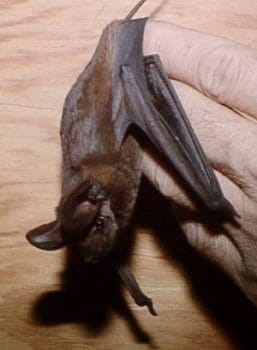 Photo: M. Siders |  Big Free-tailed Bat(Nyctinomops macrotis)Family: Molossidae (Free-tailed Bats) Size: 5.1 - 5.6 in (13 - 14 cm) Status: native; prevalence not known Habitat: rocky areas, dry forests, desert; roosts in tree holes, caves, and buildings The Big Free-tailed Bat has a tail that extends beyond its body and long, narrow tapering wings. This wing shape gives it speed but limits its maneuverability. They forage primarily for moths in total darkness, not leaving their roost until well after sunset. They prefer to roost in rocky crevices but can also be found in buildings and up in trees. Females form nursing colonies. They are a migratory species and travel back and forth from Mexico to the southwestern United States. Info Photos Distribution |
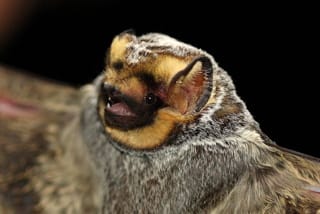 Photo: J.N. Stuart |  Hoary Bat(Lasiurus cinereus)Family: Vespertilioninae (Vesper Bats) Size: 4.5 - 6 in (11 - 15 cm) Status: native; prevalence not known Habitat: deciduous and coniferous forest; roosts in foliage The Hoary Bat is a large dark bat with white grizzled fur and a yellow collar. Its flight is distinctive – very fast and straight. It usually roosts alone in trees and tends to hunt mostly for moths over open areas or water. Although they occasionally may be seen flying on warm winter afternoons, they tend to be most active several hours after sunset. In general Hoary Bats are solitary. However, they can form groups when hunting as well as in spring and autumn during the breeding and migration seasons. While most of these bats migrate for the winter, they hibernate openly on trees in some parts of the Southwest. Info Photos Distribution |
 Photo: J.N. Stuart |  Mexican Free-tailed Bat, Brazilian Free-tailed Bat(Tadarida brasiliensis)Family: Molossidae (Free-tailed Bats) Size: 3.5 - 4.3 in (9 - 11 cm) Status: native; prevalence not known Habitat: deserts, canyons, farmlands; roosts in caves Typical location: Frijoles Canyon The Mexican Free-tailed Bat has large ears, a short snout with wrinked upper lips and a distinctive “free-tail”. Its flight is quick, straight and very high. These bats start to forage after sunset and continue throughout the night for potentially many miles/kilometers to reach a feeding area. They use echolocation to locate moths, beetles, flies and other insects. They use a variety of roosting sites including caves and man-made structures. In summer these bats will form nursery colonies. They typically migrate for the winter to Mexico. Info Photos Distribution |
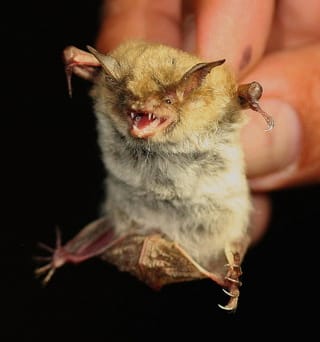 Photo: J.N. Stuart 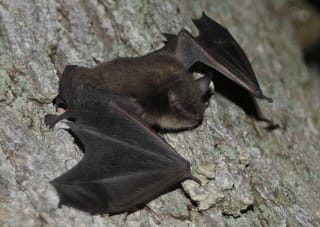 Photo: J.N. Stuart |  Mouse-eared Bats(Myotis myotis, Myotis spp.)Family: Vespertilioninae (Vesper Bats) Size: 2 - 4 in (5 - 10 cm) Status: native; prevalence not known Habitat: rocky canyons and caves, forests and woodlands, buildings, under bridges, in hollow trees Bats in the genus Myotis have ears that are normally longer than they are wide and a distinctive shape to its inner side giving the genus name of “mouse-eared”. There are numerous Myotis species in the area. Mouse-eared Bats found in Los Alamos include California Myotis (M. californicus), Long-eared Myotis (M. evotis), Western Small-footed Myotis (M. ciliolabrum), Long-legged Myotis (M. volans), Fringed Myotis (M. thysanodes), Yuma Myotis (M. yumanensis; top photo) and Little Brown Bat (M. lucifugus; bottom photo). Mouse-eared Bats are primarily nocturnal and insectivorous. They often enter a daytime torpor and hibernate during colder weather. They typically roost in areas like caves where they can cluster together but will use hollow trees and rock crevices. Info Photos Distribution |
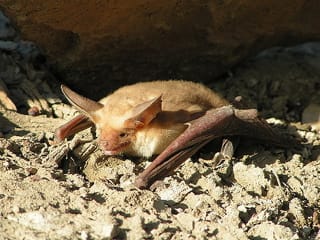 Photo: Keaton Wilson |  Pallid Bat(Antrozous pallidus)Family: Vespertilioninae (Vesper Bats) Size: 4.3 - 5.1 in (11 - 13 cm) Status: native; prevalence not known Habitat: canyons and cave, cities, suburbs, towns; roosts in buildings, crevices, overhangs The Pallid Bat has creamy yellow fur with a wooly feel. It is very sociable and usually lives in colonies with 20 or more other individuals. It uses vocalization to locate other members of its species. Pallid Bats fly close to the ground and use both echolocation and passive listening to locate prey such as beetles, grasshoppers, moths as well as other invertebrates. They will actually feed on the ground after capturing ground-dwelling prey. They will enter a state of torpor during the day and hibernate in cold weather. Info Photos Distribution |
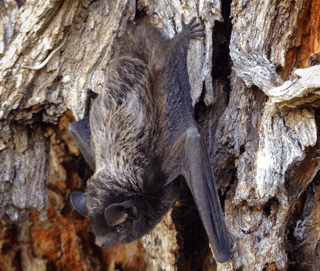 Photo: adamdv18 |  Silver-haired Bat(Lasionycteris noctivagans)Family: Vespertilioninae (Vesper Bats) Size: 3.6 - 4.3 in (9 - 11 cm) Status: native; prevalence not known Habitat: deciduous and coniferous forests, canyons and caves; roosts in trees and buildings Silver-haired Bats have dark-brown fur with silver tips on their backs. They are slow flyers with a keen ability to easily maneuver low over the ground and running water. They primarily eat soft-bodied insects like moths but will also consume spiders. They forage multiple times throughout the evening and night using echolocation both to locate food as well as to communicate with other bats. Silver-haired bats are solitary animals and use areas under loose bark or inside hollow cavities for roosting. They will, however, swarm during fall migration when mating occurs. Info Photos Distribution |
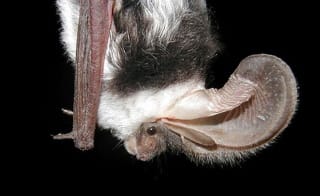 Photo: Paul Cryan |  Spotted Bat(Euderma maculatum)Family: Vespertilioninae (Vesper Bats) Size: 4.3 - 4.5 in (11 - 11 cm) Status: native; prevalence not known Habitat: mountainous regions with pine, lowland deserts, roosts in rocky cliffs and canyons Spotted Bats have very large ears and three distinctive white spots on their black backs, one on each shoulder and one on the rump. Their underbelly is white. They are rarely seen but seem to prefer habitat with a water source like a creek, river or lake. They feed on a variety of insects but primarily catch moths and eat only the abdomens. They are unusual in that their echolocation sound is low enough to be heard by humans. Spotted Bats are solitary and territorial. Some of them migrate to warmer areas during winter but others remain in their home territories and enter a state of torpor during the colder months. Info Photos Distribution |
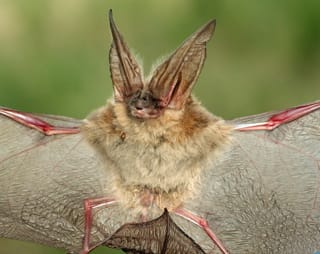 Photo: J.N. Stuart |  Townsend's Big-eared Bat(Corynorhinus townsendii, Plecotus townsendii)Family: Vespertilioninae (Vesper Bats) Size: 3.5 - 4.3 in (9 - 11 cm) Status: native; prevalence not known Habitat: desert, pine forest; roosts in caves and sometimes buildings Townsend’s Big-eared Bats have ears so long and flexible that they almost look like another set of wings. They feed almost exclusively on moths which they hunt over large areas and in the forest canopy. However they will also catch and eat beetles, flies and other small insects. They use echolocation for navigation and sensing as well as utilizing other sounds for communication. These bats require roosting sites with large open areas such in an abandoned buildings, mines, caves or under ledges. During winter they hibernate in small groups in areas that are almost completely dark and are very sensitive to human disturbance. Info Photos Distribution |
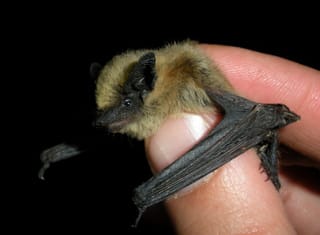 Photo: ErinAdventure |  Western Pipistrelle, Canyon Bat(Pipistrellus hesperus, Parastrellus hesperus)Family: Vespertilioninae (Vesper Bats) Size: 2.4 - 3.4 in (6 - 9 cm) Status: native; prevalence not known Habitat: deserts, rocky areas, canyons, towns; roosts in caves, mines and buildings The Western Pipistrelle is the smallest bat in the United States and may be mistaken for a large moth. It is usually the first bat to leave its roost in the evening and the last to return after sunrise. However, it is not usually active in the middle of the night. Pipistrelles mostly feed on swarming insects like moths, flies, beetles, mosquitoes and wasps. Their flight pattern when pursuing flying prey appears slow, fluttery and erratic. While they hibernate during cold weather, they are not know to congregate in large groups but are most often found singly in mines, caves or rocky crevices. Info Photos Distribution |
